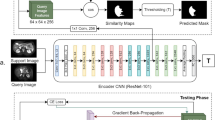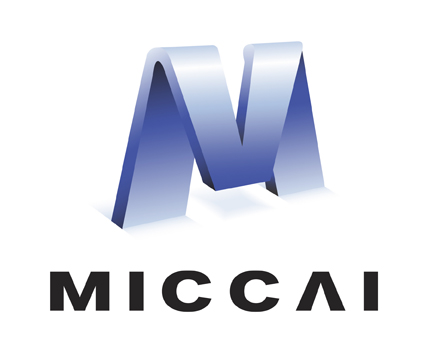Abstract
As deep learning methods continue to improve medical image segmentation performance, data annotation is still a big bottleneck due to the labor-intensive and time-consuming burden on medical experts, especially for 3D images. To significantly reduce annotation efforts while attaining competitive segmentation accuracy, we propose a self-learning and one-shot learning based framework for 3D medical image segmentation by annotating only one slice of each 3D image. Our approach takes two steps: (1) self-learning of a reconstruction network to learn semantic correspondence among 2D slices within 3D images, and (2) representative selection of single slices for one-shot manual annotation and propagating the annotated data with the well-trained reconstruction network. Extensive experiments verify that our new framework achieves comparable performance with less than \(1\%\) annotated data compared with fully supervised methods and generalizes well on several out-of-distribution testing sets.
Access this chapter
Tax calculation will be finalised at checkout
Purchases are for personal use only
Similar content being viewed by others
References
Bengio, S., Vinyals, O., et al.: Scheduled sampling for sequence prediction with recurrent neural networks. In: NIPS, vol. 28 (2015)
Bilic, P., Christ, P.F., et al.: The liver tumor segmentation benchmark (LiTS). ArXiv preprint arXiv:1901.04056 (2019)
Bitarafan, A., Nikdan, M., et al.: 3D image segmentation with sparse annotation by self-training and internal registration. JBHI 25(7), 2665–2672 (2020)
Chang, Y.T., Wang, Q., et al.: Weakly-supervised semantic segmentation via sub-category exploration. In: CVPR, pp. 8991–9000 (2020)
Chen, L.C., Papandreou, G., et al.: Semantic image segmentation with deep convolutional nets and fully connected CRFs. ArXiv preprint arXiv:1412.7062 (2014)
Chen, L.C., Papandreou, G., et al.: DeepLab: semantic image segmentation with deep convolutional nets, atrous convolution, and fully connected CRFs. TPAMI 40, 834–848 (2017)
Chen, L.C., Zhu, Y., et al.: Encoder-decoder with atrous separable convolution for semantic image segmentation. In: ECCV (2018)
Çiçek, Ö., Abdulkadir, A., Lienkamp, S.S., Brox, T., Ronneberger, O.: 3D U-Net: learning dense volumetric segmentation from sparse annotation. In: Ourselin, S., Joskowicz, L., Sabuncu, M.R., Unal, G., Wells, W. (eds.) MICCAI 2016. LNCS, vol. 9901, pp. 424–432. Springer, Cham (2016). https://doi.org/10.1007/978-3-319-46723-8_49
Dai, C., et al.: Suggestive annotation of brain tumour images with gradient-guided sampling. In: Martel, A.L., et al. (eds.) MICCAI 2020. LNCS, vol. 12264, pp. 156–165. Springer, Cham (2020). https://doi.org/10.1007/978-3-030-59719-1_16
Gabor, D.: Theory of communication. Part 1: the analysis of information. J. Inst. Electr. Eng. Part III: Radio Commun. Eng. 93(26), 429–441 (1946)
He, K., Chen, X., et al.: Masked autoencoders are scalable vision learners. ArXiv preprint arXiv:2111.06377 (2021)
He, K., Zhang, X., et al.: Deep residual learning for image recognition. In: CVPR, pp. 770–778 (2016)
Huang, Z., Wang, X., et al.: Weakly-supervised semantic segmentation network with deep seeded region growing. In: CVPR, pp. 7014–7023 (2018)
Isensee, F., Jaeger, P.F., et al.: nnU-Net: a self-configuring method for deep learning-based biomedical image segmentation. Nat. Methods 18, 203–211 (2021)
Kavur, A.E., Gezer, N.S., et al.: CHAOS challenge-combined (CT-MR) healthy abdominal organ segmentation. MIA 69, 101950 (2021)
Kervadec, H., Dolz, J., et al.: Constrained-CNN losses for weakly supervised segmentation. MIA 54, 88–99 (2019)
Khoreva, A., Benenson, R., et al.: Simple does it: weakly supervised instance and semantic segmentation. In: CVPR, pp. 876–885 (2017)
Kingma, D.P., Ba, J.: Adam: a method for stochastic optimization. arXiv preprint arXiv:1412.6980 (2014)
Kolesnikov, A., Lampert, C.H.: Seed, expand and constrain: three principles for weakly-supervised image segmentation. In: Leibe, B., Matas, J., Sebe, N., Welling, M. (eds.) ECCV 2016. LNCS, vol. 9908, pp. 695–711. Springer, Cham (2016). https://doi.org/10.1007/978-3-319-46493-0_42
Krishna, K., Murty, M.N.: Genetic K-means algorithm. IEEE Trans. Syst. Man Cybern. Part B (Cybern.) 29(3), 433–439 (1999)
Long, J., Shelhamer, E., et al.: Fully convolutional networks for semantic segmentation. In: CVPR (2015)
Milletari, F., Navab, N., et al.: V-Net: fully convolutional neural networks for volumetric medical image segmentation. In: 3DV (2016)
Papandreou, G., Chen, L.C., et al.: Weakly-and semi-supervised learning of a deep convolutional network for semantic image segmentation. In: ICCV, pp. 1742–1750 (2015)
Pathak, D., Krahenbuhl, P., et al.: Context encoders: feature learning by inpainting. In: CVPR, pp. 2536–2544 (2016)
Ronneberger, O., Fischer, P., Brox, T.: U-Net: convolutional networks for biomedical image segmentation. In: Navab, N., Hornegger, J., Wells, W.M., Frangi, A.F. (eds.) MICCAI 2015. LNCS, vol. 9351, pp. 234–241. Springer, Cham (2015). https://doi.org/10.1007/978-3-319-24574-4_28
Shi, X., Dou, Q., Xue, C., Qin, J., Chen, H., Heng, P.-A.: An active learning approach for reducing annotation cost in skin lesion analysis. In: Suk, H.-I., Liu, M., Yan, P., Lian, C. (eds.) MLMI 2019. LNCS, vol. 11861, pp. 628–636. Springer, Cham (2019). https://doi.org/10.1007/978-3-030-32692-0_72
Simpson, A.L., Antonelli, M., et al.: A large annotated medical image dataset for the development and evaluation of segmentation algorithms. ArXiv preprint arXiv:1902.09063 (2019)
Song, C., Huang, Y., et al.: Box-driven class-wise region masking and filling rate guided loss for weakly supervised semantic segmentation. In: CVPR, pp. 3136–3145 (2019)
Tajbakhsh, N., Hu, Y., et al.: Surrogate supervision for medical image analysis: effective deep learning from limited quantities of labeled data. In: ISBI, pp. 1251–1255. IEEE (2019)
Taleb, A., Lippert, C., Klein, T., Nabi, M.: Multimodal self-supervised learning for medical image analysis. In: Feragen, A., Sommer, S., Schnabel, J., Nielsen, M. (eds.) IPMI 2021. LNCS, vol. 12729, pp. 661–673. Springer, Cham (2021). https://doi.org/10.1007/978-3-030-78191-0_51
Taleb, A., Loetzsch, W., et al.: 3D self-supervised methods for medical imaging. In: NIPS, vol. 33, pp. 18158–18172 (2020)
Van Ginneken, B., Heimann, T., et al.: 3D segmentation in the clinic: a grand challenge. In: MICCAI Workshop on 3D Segmentation in the Clinic: A Grand Challenge, vol. 1, pp. 7–15 (2007)
Vincent, P., Larochelle, H., et al.: Stacked denoising autoencoders: learning useful representations in a deep network with a local denoising criterion. JMLR 11(12), 3371–3408 (2010)
Vondrick, C., Shrivastava, A., et al.: Tracking emerges by colorizing videos. In: ECCV, pp. 391–408 (2018)
Wang, X., Jabri, A., et al.: Learning correspondence from the cycle-consistency of time. In: CVPR, pp. 2566–2576 (2019)
Wang, Z., Yin, Z.: Annotation-efficient cell counting. In: de Bruijne, M., et al. (eds.) MICCAI 2021. LNCS, vol. 12908, pp. 405–414. Springer, Cham (2021). https://doi.org/10.1007/978-3-030-87237-3_39
Yang, G., Wang, C., et al.: Weakly-supervised convolutional neural networks of renal tumor segmentation in abdominal CTA images. BMC Med. Imaging 20(1), 1–12 (2020)
Yang, L., Zhang, Y., Chen, J., Zhang, S., Chen, D.Z.: Suggestive annotation: a deep active learning framework for biomedical image segmentation. In: Descoteaux, M., Maier-Hein, L., Franz, A., Jannin, P., Collins, D.L., Duchesne, S. (eds.) MICCAI 2017. LNCS, vol. 10435, pp. 399–407. Springer, Cham (2017). https://doi.org/10.1007/978-3-319-66179-7_46
Zhao, A., Balakrishnan, G., et al.: Data augmentation using learned transformations for one-shot medical image segmentation. In: CVPR, pp. 8543–8553 (2019)
Zheng, H., Yang, L., et al.: Biomedical image segmentation via representative annotation. In: AAAI, vol. 33, pp. 5901–5908 (2019)
Zheng, H., Zhang, Y., et al.: An annotation sparsification strategy for 3D medical image segmentation via representative selection and self-training. In: AAAI, vol. 34, pp. 6925–6932 (2020)
Acknowledgments
This research was partially supported by National Key R\( { \& }\)D Program of China under grant No. 2019YFC0118802, National Natural Science Foundation of China under grants No. 62176231, Zhejiang public welfare technology research project under grant No. LGF20F020013, D. Z. Chen’s research was supported in part by NSF Grant CCF-1617735.
Author information
Authors and Affiliations
Corresponding author
Editor information
Editors and Affiliations
Rights and permissions
Copyright information
© 2022 The Author(s), under exclusive license to Springer Nature Switzerland AG
About this paper
Cite this paper
Wu, Y., Zheng, B., Chen, J., Chen, D.Z., Wu, J. (2022). Self-learning and One-Shot Learning Based Single-Slice Annotation for 3D Medical Image Segmentation. In: Wang, L., Dou, Q., Fletcher, P.T., Speidel, S., Li, S. (eds) Medical Image Computing and Computer Assisted Intervention – MICCAI 2022. MICCAI 2022. Lecture Notes in Computer Science, vol 13438. Springer, Cham. https://doi.org/10.1007/978-3-031-16452-1_24
Download citation
DOI: https://doi.org/10.1007/978-3-031-16452-1_24
Published:
Publisher Name: Springer, Cham
Print ISBN: 978-3-031-16451-4
Online ISBN: 978-3-031-16452-1
eBook Packages: Computer ScienceComputer Science (R0)





